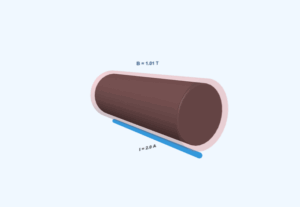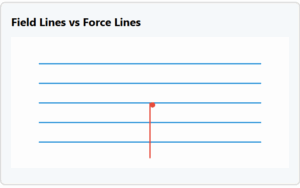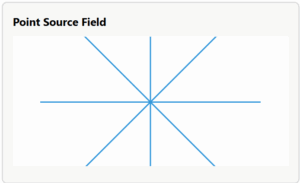Magnetic Dipole Equilibrium Simulation
This simulation demonstrates the equilibrium configurations of two magnetic dipoles (P and Q):
Example
Question:
Figure 5.4 shows a small magnetised needle \(P\) placed at a point \(O\). The arrow shows the direction of its magnetic moment. The other arrows show different positions (and orientations of the magnetic moment) of another identical magnetised needle \(Q\).
(a) In which configuration the system is not in equilibrium?
(b) In which configuration is the system in (i) stable, and (ii) unstable equilibrium?
(c) Which configuration corresponds to the lowest potential energy among all the configurations shown?
Solution:
The potential energy of the configuration arises due to the potential energy of a dipole (\(Q\)) in the magnetic field due to the other (\(P\)).
The field due to \(P\) (on normal bisector):
\[
\mathbf{B}_P = -\frac{\mu_0 m_p}{4\pi r^3}
\]
On the axis:
\[
\mathbf{B}_P = \frac{\mu_0 2 m_p}{4\pi r^3}
\]
where \(m_p\) is the magnetic moment of dipole \(P\).
Equilibrium is stable when \(m_Q\) is parallel to \(\mathbf{B}_P\), unstable when anti-parallel.
Thus:
(a) \(PQ_1\) and \(PQ_2\) are not in equilibrium.
(b) (i) Stable: \(PQ_3\), \(PQ_6\); (ii) Unstable: \(PQ_5\), \(PQ_4\).
(c) \(PQ_6\) corresponds to the lowest potential energy among all shown configurations.
Physics Explanation:
The potential energy of the configuration arises due to the potential energy of dipole Q in the magnetic field due to dipole P.
Key concepts:
- Stable equilibrium: Magnetic moment of Q is parallel to P's magnetic field
- Unstable equilibrium: Magnetic moment of Q is anti-parallel to P's magnetic field
- Not in equilibrium: When the torque on Q is non-zero
(a) Not in equilibrium: PQ₁ and PQ₂
(b) (i) Stable equilibrium: PQ₃, PQ₆; (ii) Unstable equilibrium: PQ₅, PQ₄
(c) Lowest potential energy: PQ₆



